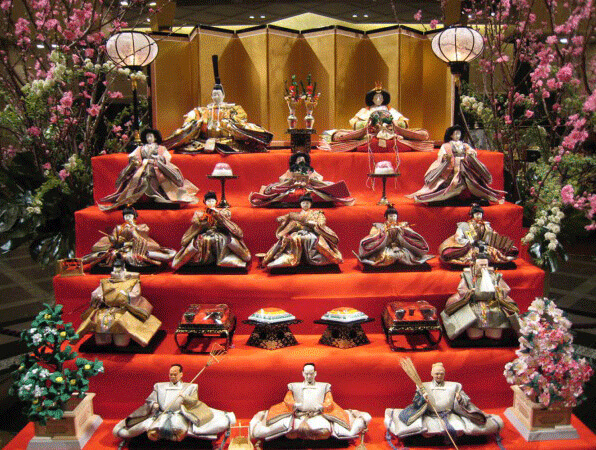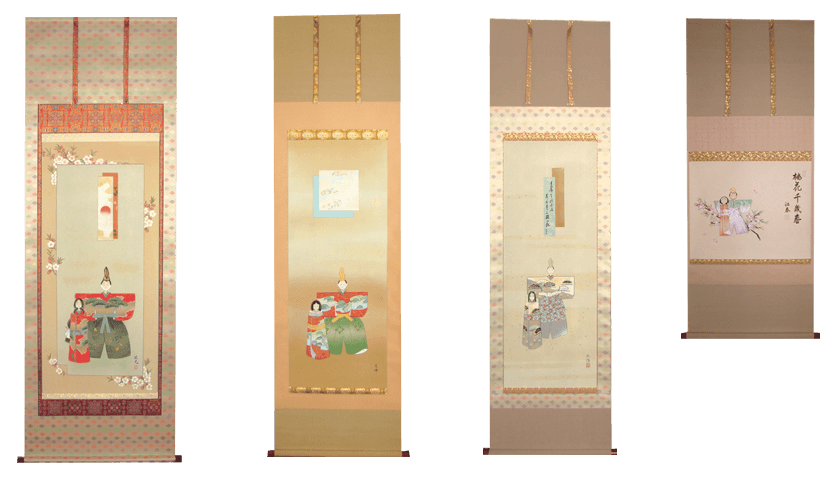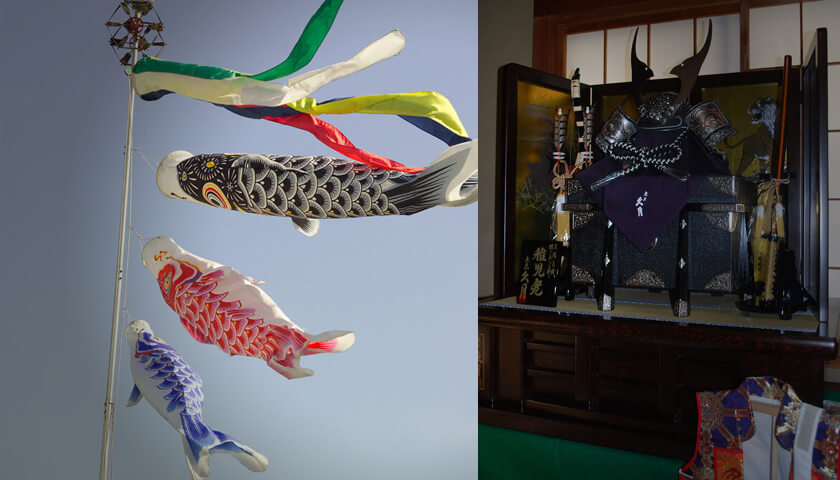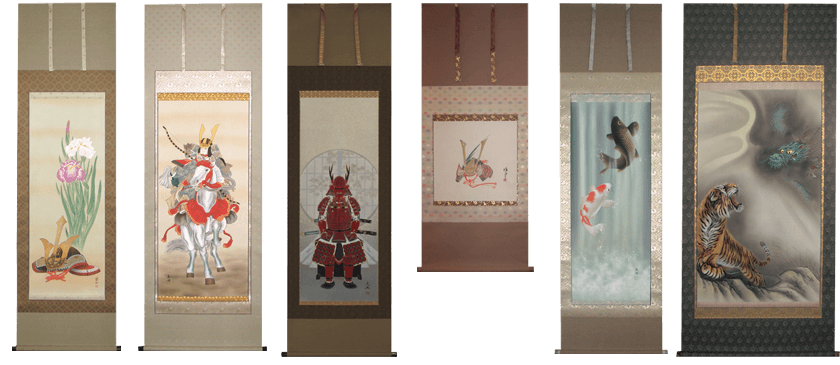Lesson
News / Blog
Other Menus
The Girl’s or Boy’s Festival Kakejiku
Hinamatsuri and Tango-no-sekku
Hinamatsuri
Tango-no-sekku
Seasonal Festival Kakejiku
‘Sekku’ is a Chinese custom which is held based on an almanac and has been adjusted to a Japanese lifestyle at the time of the introduction from China. Among the existing five seasonal festivals, “Momo-no-sekku /peach festival” and “Tango-no-sekku / the boy’s festival” are the festivals wishing for healthy growth of children. The former one is for girls and the latter one, for boys.
This time, I would like to introduce these two seasonal festivals as well as the types of kakejiku meant to be displayed for the celebrations called ‘Sekku Gake / seasonal festival kakejiku’.
Hina-matsuri

“Hina-matsuri” (The Japanese Doll Festival) is an annual event. It is a seasonal festival to pray for the healthy growth of girls. In Japan, Hina-matsuri used to be observed on March 3, of the old calendar (around present-day April). It was on the first day of March, the Snake month, according to the Japanese lunar-solar calendar. However, after the calendar reform of January 1, 1873, the festival has generally been celebrated on March 3, according to the Gregorian calendar (or new calendar). However, in some parts of Japan, mainly snowy regions such as the Tōhoku region, Hina-matsuri is still observed on March 3rd of the old calendar. There are other regions that celebrate the festival on April 3rd, in line with the new calendar. Hina-matsuri was also named “Momo-no-(peach’s) sekku” because the festival, under the old calendar, was held when peach trees blossomed.
Hina-matsuri is a seasonal festival in which dolls are displayed, and centering around two dolls representing the emperor, called “obina,” and the empress, called “mebina.” The display is decorated with peach flowers, and people enjoy eating and drinking “shirozake” (sweet white sake).
During the Edo period, the girls’ “doll play” was combined with the “ceremony of the seasonal festival.” Hina-matsuri spread across the country, and dolls began to be displayed. During this period, however, in addition to the traditional aspects of the doll display, Hina-matsuri increasingly came to have a ritualistic aspect, in which the dolls suffer all of the present and future misfortunes, in the place of people. Also at this time, the Hina-matsuri doll set came to be considered one of the bride’s household articles for high-ranking females, such as the daughters of “samurai” families. As a result, the doll trend became more elegant and luxurious.
Kakejikus for Momo-No-Sekku /The Peach Festival
‘Tachibina’
‘Tachibina’ the kakejiku which depicts standing obina and mebina is the quintessential kakejiku for the peach festival if not the only kakejiku. Judging from my experience through my business, over 90% of the kakejiku for the festival is ‘tachibina’. The examples of a minor motif of the kakejiku for the event will be ‘tiered-display of the dolls’ and ‘peach’ and ones for seasonal kakejiku such as ‘plum/cherry blossoms’ displayed behind the dolls exhibited in an alcove.
‘Tachibina’ is said to be a motif already so widespread by the Edo period that it is painted by the legendary painters like Tomioka Tessai, Kikuchi Yōsai, and Tosa Mitsuzane and the fact that even after the Meiji period, it was chosen as the motif by artists such as Hishida Shunsō, Nakamura Daizuaburō, and Taniguchi Kōkyō explains its popularity. The motif circulated around the time was commonly a simple depiction of two dolls. However, the majority of the postwar motifs of those gained more variety with additionally painted strips of fancy papers in various shapes above the dolls.
Personally, something intriguing about the kakejiku with the ‘tachibina’ motif is the customers’ reason for the purchase. It could be a reason that they already bought hina dolls for older daughter so for younger daughter the kakejiku is to gain or they would rather put on show a kakejiku than display a tiered-display of the dolls that is burdensome to assemble, and in some cases, it is even a mature lady’s demand for having their own seasonal kakejiku even though the kakejiku is meant to be displayed for girls as a prayer for their healthy growth. These customers make me smile as I can get a glimpse of women’s wish for staying ‘a young girl’ forever. There is even a case of a lady over 80 years of age purchasing one with the thought and that precious experiences let me contemplate how extensive the needs for kakejiku are.

Tango-no-Sekku / The Boy’s Festival

The Japanese have a custom of holding a variety of events praying for the healthy growth of boys, on the day of Tango-no-sekku, and May 5 is a national holiday, called “Children’s Day.” In a few regions, it is celebrated on June 5th, following the old lunar calendar.
In Japan, there was a ritual called “Satsuki-imi” (literally, accursed May), where all the men went out of the house, and only women stayed inside to wash the impurities away and purify themselves before rice planting. This custom was connected to “tango,” which came from China. In the Imperial Palace, people wearing a Japanese iris in their hair got together at the “Butokuden” (a palace building) and were granted a “Kusudama” (literally, a ball of medicine made of herbs with decoration added) by the emperor. A record from the Nara period described these events in the imperial court.
The word for the Japanese iris was pronounced the same as the word for martial spirit (both were pronounced “shōbu”), and the shape of the leaves of the Japanese iris reminds people of swords. Therefore, tango was determined as the “sekku” for boys, and people prayed for the healthy growth of boys during the Kamakura period.
The typical way to celebrate tango-no-sekku is to display armor, a helmet, a sword, a doll warrior, or a “gogatsu-ningyō” doll (literally, a doll of May) modeled after Kintarō (a famous brave boy in a nursery tale) on a tiered stand in a room, and to fly “Koi-nobori” (carp streamers) on a pole in the front yard. Displaying armor symbolizes protecting the boys. The custom of displaying koi-nobori originates in the Chinese tradition, and it is meant to pray for the success in a boy’s life.
Kakejikus for The Boy’s Festival
Contrary to the peach festival whose representing kakejiku is almost solely ‘Tachibina’, a wide range of kakejikus are available for the Boy’s Festival. I am going to detail representative kakejikus for the Boy’s Festival to you.
Japanese Iris
As previously mentioned, because the Japanese iris is deeply associated with the Boy’s Festival, kakejikus with the motif are generally displayed for the celebration. Since the season of the flower is concurrent with the festival’s, the plant is matching seasonally as well and as you might think, after the festival they are also displayed as a seasonal kakejiku in some cases.
Not limited to the kakejiku with a motif of nothing but Japanese iris, the kakejiku whose motif portrayed the iris along with a helmet is frequently put on a show as the combination appears to be more appropriate for the Boy’s Festival. ‘The Japanese iris and a helmet’ is a well-known motif.
Armored warrior
Reflecting the future image of a boy in a sturdy armored warrior, a kakejiku with an ‘armored warrior’ depiction is displayed. Since the ruling period of samurai was stretched from the Kamakura period to the Edo period, the tough ‘samurai’ has been the masculine and ideal figure in Japan and still today.
To distinguish who is the depicted armored warrior is insignificant still a kakejiku presenting a historical scene which is made by a renowned samurai is occasionally displayed at the Boy’s Festival.
Armor, Helmet
Kakejikus with a motif portraying a single armor or helmet the samurai wears are displayed from time to time. There used to be a number of kakejikus with no more than an armor depiction yet nowadays, the ones with just a helmet portrayal seem like the absolute mainstream.
Both motifs are supposed to be a prayer for either a boy’s growth becoming a man like a strong armored warrior who put them on or protection against calamities.
Waterfall Climbing Carp
The kakejiku is expressing carps vigorously climbing up a waterfall. This kakejiku and ‘carp streamer’ share the reason for being displayed and it originates from an ancient Chinese legend saying that once upon a time, among all the fishes that made a challenge, only a carp successfully climbed up the Ryūmon waterfall located at a headstream of the Yellow River and turned into a dragon. It is said that the carp has been conceived to be the symbol of advancement in life since then.
Despite being selected as a subject by a great number of artists from old times, among those carp motifs, the one displayed at the Boy’s Festival is solely ‘Waterfall Climbing Carp’. Motifs with carps swimming ordinarily are around yet, kakejikus with the painting are not displayable for the festival meanwhile interestingly, kakejikus portraying the waterfall climbing carps would be left to display, playing a role of a seasonal kakejiku for summer after the festival is over.
Black carp used to be the general subject of the motif but in recent days, additionally, those of the multihued colored carp Nishikigoi climbing up a waterfall has also come into common.
Dragon and Tiger
Since long ago, both the dragon and the tiger are believed to ward off catastrophes with their mighty power, and having that impression the motif of them is occasionally displayed at the Boy’s Festival. The familiar style of display is presenting a dragon or tiger kakejiku behind a doll for the festival such as a kabuto/ornamental helmet placed in an alcove. The space overwhelmed with the powerful aura will give evils absolutely no chance to slip in. I would say, the room with perfection.
As a motif for a usual kakejiku, the dragon and the tiger depictions are displayable as well. Therefore, some people own them for both opportunities.


